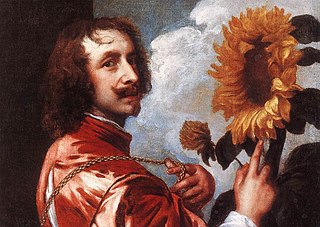
Sir Anthony van Dyck was a Flemish Baroque artist who became the leading court painter in England after success in the Spanish Netherlands and Italy.

Dulwich Picture Gallery is an art gallery in Dulwich, South London. It opened to the public in 1817 and was designed by the Regency architect Sir John Soane by using an innovative and influential method of illumination. It is the oldest public art gallery in England and was made an independent charitable trust in 1994. Until then, the gallery was part of the College of God's Gift, a charitable foundation established by the actor, entrepreneur and philanthropist Edward Alleyn in the early 17th century. The acquisition of artworks by its founders and bequests from its many patrons resulted in Dulwich Picture Gallery housing one of the country's finest collections of Old Masters, especially rich in French, Italian and Spanish Baroque paintings, and in British portraits from the Tudor era to the 19th century.
Samson and Delilah are Biblical figures.

The Massacre of the Innocents is the subject of two paintings by Peter Paul Rubens depicting the episode of the biblical Massacre of the Innocents of Bethlehem, as related in the Gospel of Matthew (2:13-18). The first, measuring 142 x 182 cm, was painted after his return to his native Antwerp in 1608, following eight years spent in Italy.

The Picture Gallery in the Sanssouci Park of Potsdam was built in 1755–64 during the reign of Frederick II of Prussia under the supervision of Johann Gottfried Büring. The Picture Gallery is situated east of the palace and is the oldest extant museum built for a ruler in Germany.
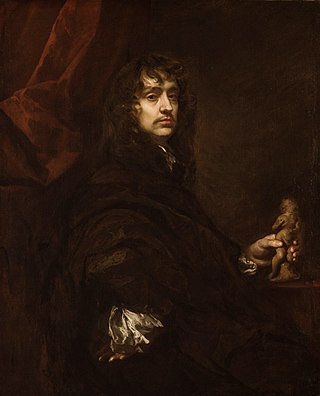
Sir Peter Lely was a painter of Dutch origin whose career was nearly all spent in England, where he became the dominant portrait painter to the court. He became a naturalised British subject and was knighted in 1679.
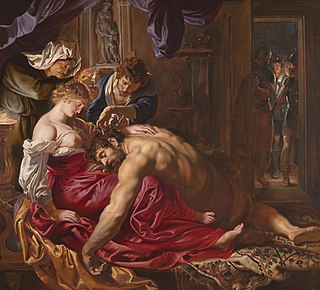
Samson and Delilah is a painting long attributed to the Flemish Baroque painter Peter Paul Rubens (1577–1640) and displayed in the National Gallery. It dates from about 1609 to 1610.

Flemish Baroque painting was a style of painting in the Southern Netherlands during Spanish control in the 16th and 17th centuries. The period roughly begins when the Dutch Republic was split from the Habsburg Spain regions to the south with the Spanish recapturing of Antwerp in 1585 and goes until about 1700, when Spanish Habsburg authority ended with the death of King Charles II. Antwerp, home to the prominent artists Peter Paul Rubens, Anthony van Dyck, and Jacob Jordaens, was the artistic nexus, while other notable cities include Brussels and Ghent.
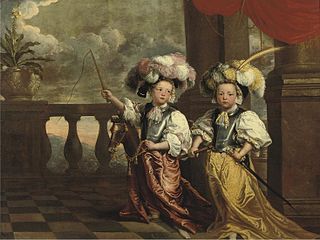
Johanna Vergouwen was a Flemish Baroque painter and copyist.

Cornelis van der Geest was a spice merchant from Antwerp, who used his wealth to support the Antwerp artists and to establish his art collection. He was also the dean of the haberdashers guild.

Saint Ambrose barring Theodosius from Milan Cathedral is a painting of c. 1619–20 by Anthony van Dyck in the National Gallery, London.

Entry of Christ into Jerusalem is a 1617 oil painting by Flemish artist Anthony van Dyck, located in the Indianapolis Museum of Art, which is in Indianapolis, Indiana. It depicts Jesus entering Jerusalem as described in the Gospels, the event celebrated on Palm Sunday.

Samson and Delilah is a 1630 painting by Anthony van Dyck. Like his 1620 version of the subject, it is in the style of his former master Peter Paul Rubens. Unlike Rubens, however, van Dyck shows Delilah seemingly appalled at her own betrayal of Samson and regretting her act of treason, whereas Rubens showed him as a captive and her as an unscrupulous temptress. Van Dyck's palette in the work also reveals the influence of Titian during van Dyck's stay in Italy. It is now in the Kunsthistorisches Museum in Vienna.

St Martin Dividing his Cloak is a painting by the Flemish painter Anthony van Dyck dated around 1618, which is an altarpiece in the Sint-Martinuskerk in Zaventem, Belgium. The painting portrays the story of Saint Martin sharing his cloak with a beggar. This early work of van Dyck was painted when he was strongly influenced by Rubens's style.

Nicolaas Rockox (1560–1640), was a mayor of Antwerp. He was a close personal friend and important patron of Peter Paul Rubens. His residence in Antwerp is now a museum known as the Rockox House. He was knighted by Archduke Albert and Isabella, the Governor General of the Southern Netherlands.

Saint Rosalia Crowned by Angels is an oil on canvas painting by the studio of Anthony van Dyck, created c. 1624, one of several works showing the saint produced whilst van Dyck was quarantined in Palermo, Sicily due to a plague. It is now in the Galleria Regionale del Palazzo Abatellis in Palermo, where in 2015 it was displayed alongside Saint Rosalie Interceding, loaned from the Metropolitan Museum of Art.

Saint Rosalia Crowned by Angels is a c. 1625 oil on canvas painting by Anthony van Dyck, one of five surviving works showing the saint which he produced whilst he was quarantined in Palermo, Sicily due to a plague. It is now in the Menil Collection in Houston, Texas, which bought it in 1968. It was loaned from there in 2011-2012 to the Dulwich Picture Gallery in London.
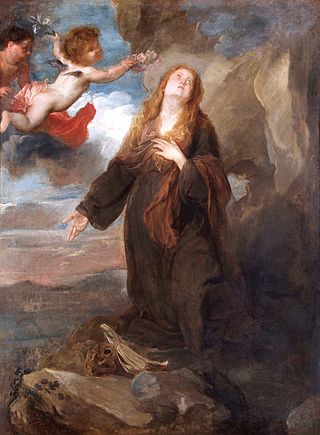
Saint Rosalia Crowned by Angels is a c. 1625 oil on canvas painting by Anthony van Dyck, one of five surviving works showing the saint which he produced whilst he was quarantined in Palermo, Sicily due to a plague. It is now in the Wellington Collection at Apsley House in London.

Saint Rosalia is a c.1625 oil on canvas painting by Anthony van Dyck. Originally owned by Giovan Francesco Serra di Cassano, it was bought by Philip IV of Spain via his Viceroy of Naples Gaspar de Bracamonte in 1664 and is now in the Museo del Prado in Madrid

Saint Rosalia Interceding for the City of Palermo is an oil on canvas painting of Saint Rosalia by Anthony van Dyck, now in the Museo de Arte de Ponce in Puerto Rico, which acquired it at auction at Sotheby's in London on 7 December 1960. It is sometimes dated to 1629 when the artist was back in Antwerp and sometimes to 1624-1625 whilst the artist was quarantined in Palermo, Sicily.




















